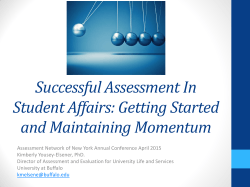
The Relationship between Epistemic Curiosity and Social
© Journal of the Indian Academy of Applied Psychology 2015, Vol. 41, No.3 (Special Issue), 187-193. The Relationship between Epistemic Curiosity and Social Desirability among Indian Students Amuda Agneswaran and Aakankshi Javeri Monk Prayogshala, Mumbai Epistemic curiosity, tendency to gossip, and social desirability are social constructs relevant to interpersonal relationships and acquisition of information. Gender and cultural factors may moderate these variables in an important manner. 100 Indian college students (Mage = 21.05, SDage = 4.41, range: 16 - 45) participated in this study, which was an exploratory research to understand the relationship between curiosity, gossip, and social desirability constructs moderated by gender in an Indian sample. It was hypothesized that the reporting of epistemic curiosity and tendencies to gossip were mediated by social desirability. MANOVAs and correlational analyses revealed that epistemic curiosity and social desirability were negatively correlated for male participants, suggesting existence of high curiosity with a low need to portray a favourable self-image. Male participants scored higher on the three constructs, implying gender differences in the Indian sample. Considerations for future research are discussed. Keywords: Gossip, Social Desirability, Epistemic Curiosity, Interpersonal Curiosity, Gender Differences. In order to function in the society, individuals constantly seek information about others in the social and relational context. Individuals are also interested in pursuing non-social knowledge, such as learning new skills. To study the relevance of curiosity and gossip constructs in the Indian context, we aimed to examine the relationship between them as well as with social desirability in an exploratory study. Epistemic Curiosity Curiosity - a desire for new information and knowledge - was divided into perceptual and epistemic curiosity by Berlyne (1954). Epistemic curiosity (EC) was the desire for knowledge that motivates individuals to learn new concepts, acquire new information, and answer questions based on such information(Berlyne, 1954; Loewenstein, 1994). Berlyne (1954) described EC as a uniquely human “drive to know” which accelerated individuals to seek knowledge. Litman and Spielberger (2003) conceptualised EC as a dispositional personality trait with positive emotional-motivational states of interest and the intrinsic pleasure of learning. Two types of EC were proposed by Litman and Jimerson (2004) - interest induction (I) and deprivation elimination (D) - reflecting different types of curiosity corresponding to different motives for acquiring new information. I-type curiosity involved the anticipated pleasure of new discoveries and the desire to learn for the joy of understanding things (similar to mastery-oriented learning). On the other hand, D-type curiosity suggested the need to know information, which was related to reducing uncertainty. The latter motivated an individual to acquire information to eliminate undesirable states of ignorance (similar to performance-oriented learning; Litman, 2008). Loewenstein (1994) proposed epistemic curiosity existed due to inconsistencies and gaps in information we already possess. Thus, it was a combination of internal, external, and situational factors that motivated an individual to bridge the information-gap, which was manifested as that individual’s curiosity. Loewenstein (1994) also proposed that individuals might resort to guesswork and speculation if the desired information was not readily available, a notion that may be applied to the tendency of individuals to engage in gossip.
© Copyright 2025












